City Center vs Suburban Accommodation Comparison
Choosing between city center and suburban accommodation can make or break your travel experience, especially when visiting major destinations across Europe and North America. As an experienced traveler who has stayed in both types of accommodations numerous times, I’ve discovered that each option offers distinct advantages depending on your travel style, budget, and itinerary. The city center vs suburban accommodation comparison isn’t just about location—it’s about accessibility, atmosphere, cost, and the type of experience you want to create. Whether you’re planning a romantic city getaway, a family vacation, or a solo adventure, understanding these differences will help you make the perfect choice for your next trip. Many travelers automatically assume city center locations are superior, but suburban options often provide unexpected benefits that might better suit your needs.
City Center vs Suburban Accommodation Comparison – Essential Differences
When conducting a thorough city center vs suburban accommodation comparison, the first aspect to consider is proximity to major attractions. City center accommodations place you within walking distance of museums, historical sites, restaurants, and nightlife, which means you can maximize your sightseeing time without worrying about transportation schedules. However, this convenience comes with trade-offs including higher noise levels, smaller room sizes, and premium pricing. Suburban accommodations typically offer more space for your money, quieter surroundings, and free parking—advantages that families and travelers seeking relaxation often prioritize. The atmosphere differs significantly too; city centers buzz with energy day and night while suburbs provide a more local, residential feel that lets you experience daily life in your destination.
Location and Accessibility Factors
- City center locations provide walkable access to 80-90% of major tourist attractions, saving you transportation costs and time
- Suburban accommodations require public transportation or rental cars but often include free parking, which can save $25-50 daily in urban areas
- Airport accessibility varies significantly—suburban locations near airport corridors can reduce transit times despite being farther from city centers
- Budget city center options: $120-200/night for basic rooms, often in older buildings without elevators or amenities
- Mid-range suburban hotels: $150-250/night for newer properties with pools, fitness centers, and included breakfast
- Luxury accommodations: $400-600/night for city center five-star properties versus $250-400 for comparable suburban resorts
- Booking.com Accommodation Data
- TripAdvisor Travel Planning Resources
Cost and Value Considerations
Your budget plays a crucial role in the city center vs suburban accommodation comparison. City center hotels typically cost 30-50% more than comparable suburban properties, with luxury properties in prime locations commanding rates of $300-600 per night versus $150-300 for similar quality suburban options. However, suburban savings might be offset by transportation costs if you need to take trains, taxis, or ride-shares multiple times daily. Families often find better value in suburbs where suites with kitchenettes and multiple bedrooms are available at city center studio prices. Business travelers on expense accounts might prefer city center convenience while budget-conscious tourists can stretch their dollars further in suburban locations.

City Center vs Suburban Accommodation Comparison – Planning Your Stay
Your travel itinerary significantly influences whether city center or suburban accommodation makes more sense for your trip. If you plan to explore museums, take evening walks through historic districts, and enjoy nightlife, city center locations provide undeniable convenience. Conversely, if you’re taking day trips outside the city, traveling by car, or prefer returning to quiet surroundings after sightseeing, suburban options might serve you better. The duration of your stay also matters—for short visits of 2-3 days, city center locations maximize your limited time, while longer stays of a week or more might justify suburban accommodations where you can settle in and appreciate the local neighborhood atmosphere. Consider your travel companions too; families with children often prefer suburban spaces while couples might enjoy romantic city center locations.
Best Time to Choose Each Accommodation Type
Seasonality affects the city center vs suburban accommodation comparison more than many travelers realize. During peak tourist seasons (summer in Europe, holidays in major cities), city center accommodations become exceptionally expensive and crowded—sometimes making suburban options not just cheaper but more pleasant. Shoulder seasons (spring and fall) often provide the best balance for city center stays with moderate prices and smaller crowds. Winter travel presents unique considerations: city center locations keep you close to indoor attractions and holiday markets while avoiding cold walks from transportation hubs, but suburban hotels might offer better value during this traditionally slower period. Festivals and special events can dramatically shift this calculation—during major events like Carnival in Venice or Oktoberfest in Munich, suburban accommodations might be your only affordable option.
Budget Planning and Cost Breakdown
Essential Preparation Checklist
Before finalizing your city center vs suburban accommodation choice, research transportation options thoroughly. For suburban stays, identify public transit routes, schedules, and costs—many European suburbs have excellent train connections that make city access surprisingly convenient. Check parking situations: city center hotels often charge $30-50 daily for parking while suburban properties typically include it free. Consider your daily itinerary—if you plan to return to your accommodation midday for naps (with children) or breaks, suburban travel time might become burdensome. Pack accordingly: city center stays allow for lighter packing since you can easily return to your room, while suburban stays might require carrying more items with you for the day. Finally, read recent reviews focusing on noise levels, neighborhood safety, and actual transit times to attractions.
City Center vs Suburban Accommodation Comparison – Experience and Atmosphere
The experiential difference between city center and suburban accommodations transforms how you engage with your destination. City center stays immerse you in the urban energy from morning until night—you’ll wake up to the sounds of the city, step outside directly into vibrant streetscapes, and have endless dining and entertainment options at your doorstep. This constant stimulation delights some travelers but overwhelms others, especially those seeking relaxation or traveling with young children. Suburban accommodations provide a retreat-like atmosphere where you can escape the tourist crowds and experience residential neighborhoods where locals actually live. You’ll discover neighborhood bakeries, parks, and restaurants that most tourists never see, creating a more authentic cultural experience despite the commute to major attractions.
Urban Immersion Opportunities
Staying in city center accommodations offers unparalleled opportunities for spontaneous discovery and extended evening activities. When your accommodation sits within the historic core, you can easily return to your room to drop off purchases, change clothes for evening activities, or take midday breaks without wasting precious vacation time in transit. The ability to pop into your hotel between sightseeing sessions means you can pack lighter and be more flexible with your schedule. Evening entertainment becomes effortlessly accessible—after dinner, you can stroll to that famous jazz club or last-minute theater tickets without worrying about catching the last train back to the suburbs. This constant accessibility particularly benefits travelers who want to photograph cities at different times of day, from morning light on historic buildings to illuminated nightscapes.
Suburban Local Experiences
Choosing suburban accommodations introduces you to aspects of destination life that most tourists completely miss. Instead of eating at restaurants designed for tourists, you’ll discover neighborhood favorites where locals gather—often with better food at lower prices. You’ll experience daily rhythms beyond the tourist bubble, from morning markets to evening neighborhood strolls. Suburban stays often provide more opportunities to interact with residents going about their daily lives, offering cultural insights that organized tours rarely provide. Many suburbs boast beautiful parks, recreational facilities, and community events that give you a more rounded understanding of your destination. For travelers returning to a city they’ve visited before, suburban accommodations offer a completely new perspective and fresh experiences beyond the main tourist attractions.
City Center vs Suburban Accommodation Comparison – Practical Considerations
The practical aspects of city center vs suburban accommodation comparison extend beyond simple location preferences to tangible factors that affect your daily travel experience. City center properties typically offer smaller rooms with limited amenities due to space constraints and higher operating costs—you might sacrifice closet space, seating areas, or modern bathrooms for the privilege of location. Suburban properties often provide more generous accommodations including separate living areas, kitchenettes, and outdoor space that enhance comfort during longer stays. Service levels can differ too: city center hotels often operate with efficiency-focused staff managing high guest turnover while suburban properties might offer more personalized service with staff who have time for conversations and recommendations. Accessibility features also vary, with newer suburban properties often offering better facilities for travelers with mobility challenges.
| Accommodation Feature | City Center Typical Offering | Suburban Typical Offering |
|---|---|---|
| Room Size | 250-350 sq ft standard rooms | 350-500 sq ft standard rooms |
| Parking Availability | Limited paid parking ($30-50/day) | Free ample parking |
| Dining Options | On-site restaurant plus endless nearby options | Often limited to hotel restaurant plus a few local options |
| Noise Levels | Moderate to high urban noise | Generally quiet except near major roads |
| Recreation Facilities | Rare due to space constraints | Often include pools, gyms, sports facilities |


